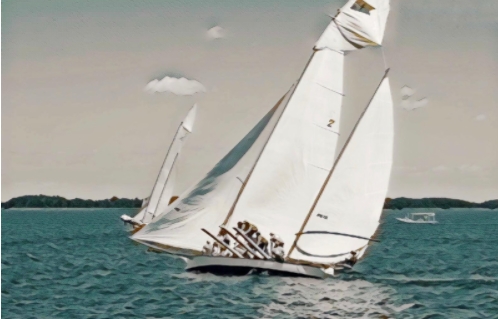In his debut book, The Tipping Point: How Little Things Can Make a Big Difference, Malcolm Gladwell defines a tipping point as “the moment of critical mass, the threshold, the boiling point.” Gladwell is attempting to explain (successfully in my opinion!) sociological change whereas I’m thinking about log canoes, those beautiful, two-masted sailing vessels that are unique to the Chesapeake Bay. At one time, log canoes were the primary oystering and fishing boats of the Bay, but when the Bugeye and the Skipjack came along, they were relegated to sailing history or to racing. Now they are the stuff of dreams, a perfect spectacle on a bluebird Sunday afternoon.
Down on Hell’s Delight in Langford Bay, it was poetry in motion, a water ballet, performed by a dozen nimble acrobats. (It’s hard to be nimble when you’re 30 feet long (give or take a few feet) and weigh a ton or two, but a good breeze has that effect on a log canoe.) Hewn from loblolly pine and constructed from several logs joined together lengthwise, the biggest log canoes require a crew of twelve or more including one lucky (lightweight) sailor who sits aft, suspended in an outrigger over the water, whose job it is to trim the mainsail. The other members of the crew are a human balancing act. Because log canoes have a bountiful sail area and almost no ballast, they need added weight to counterbalance the force of the sails. Cue the hiking boards—long, flat planks, hooked at one end under the cockpit and stuck sideways over the opposite gunwale—and the crew members who scramble out on them to keep the canoe from keeling over.
Which brings us back to the tipping point. Most of the time, the hiking boards and their human ballast keep the boats upright, but occasionally, a sudden gust of wind or an unexpected swell will cause a boat to keel over. Gravity takes over and things get out of balance. All of a sudden, you’re in the water, not flying along on it.
This is not the Gladwellian tipping point: that moment when we cross one threshold and enter new, unchartered, and potentially exciting territory. On the contrary; it seems to me that when one of those big log canoes keels over (as one did on Sunday), the crew is precisely where it doesn’t want to be: wet, cold, and out of the race. Moreover, it takes a lot of effort to right a log canoe—all that wet canvass is heavy!—as much effort, say, as it takes to heal a wound, or to right a wrong, or to eventually make your way to the finish line.
So what’s the answer? Stay in port where it’s always safe? No. Get out on the water. Boats tip over; it’s part of sailing. Do everything you can to stay upright and moving forward, but if you do tip over, learn to right the ship quickly and get back in the race. Lean as far out as you can on that hiking board; accept responsibility; tell the truth. You’ll dry off soon enough.
Jamie Kirkpatrick is a writer and photographer with homes in Chestertown and Bethesda. His work has appeared in the Washington Post, the Baltimore Sun, the Pittsburgh Post-Gazette, the Philadelphia Inquirer, the Washington College Alumni Magazine, and American Cowboy magazine. “A Place to Stand,” a book of photographs and essays about Landon School, was published by the Chester River Press in 2015. A collection of his essays titled “Musing Right Along” was released in May and is already in its second printing. Jamie’s website is www.musingjamie.com.




Alexander says
This past Sunday, the 9th of July, we had the opportunity to see the two masted log canoes playing the wind on the Chester by the Spaniard Point Reserve. What a beautiful race or as Mr. Kirkpatrick writes “it was poetry in motion, a water ballet”.
Our friend from NYC thought that the top sail was Photoshop in the pictures that we had showed him, now he know better.
We miss the keeling over of the canoe, but we can see that the probability is eminent.